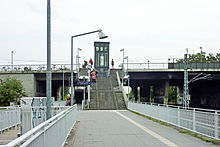Berlin Springpfuhl train station
| Berlin Springpfuhl | |
|---|---|
|
Platform, 2007
|
|
| Data | |
| Location in the network | Separation station |
| Design | Through station |
| Platform tracks | 2 |
| abbreviation | BSPH |
| IBNR | 8089040 |
| Price range | 4th |
| opening | December 30, 1976 |
| Profile on Bahnhof.de | Spring pool |
| location | |
| City / municipality | Berlin |
| Place / district | Marzahn |
| country | Berlin |
| Country | Germany |
| Coordinates | 52 ° 31 '36 " N , 13 ° 32' 12" E |
| Railway lines | |
|
|
| Railway stations in Berlin | |
Springpfuhl is an S-Bahn station in northeast Berlin in the route network of the S-Bahn Berlin . It consists of a completely covered central platform. There is a ticket office at the entrance to the street (train) bridge Allee der Kosmonauten . The transition to Helene-Weigel-Platz is designed as a tunnel with ramps. The S-Bahn lines S7 and S75 stop at the platform every ten minutes during the week. The announcements at the train station are made by a signal box at the Biesdorfer Kreuz . The station got its name from a pond of the same name only about 200 meters away .
history

The first Springpfuhl station was about 150 meters west of today's S-Bahn station on Güteraußenring (GAR). It was a pure depot with three tracks without passenger or freight transport facilities. It went into operation with the northern section between Biesenhorst and Berlin-Karow on October 6, 1941. North of the station, the GAR crossed the Wriezener Bahn with a bridge. Both routes were connected by a connecting curve between Springpfuhl at the GAR and the Berlin-Marzahn station on the Wriezener Bahn. On May 24, 1950, the northern connecting curve between the Springpfuhl Nord junction on the GAR from the direction of Karow and the Wriezener Bahn in the direction of Lichtenberg went into operation, in December 1950 a connecting curve followed between the Springpfuhl station and the Friedrichsfelde Ost junction on the Ostbahn .
In the mid-1960s, the Deutsche Reichsbahn planned to straighten the line, now known as the Berlin Outer Ring , in order to achieve higher speeds. Outer ring, Ostbahn and Wriezener Bahn were to be linked with one another via a company cross, which later became the Biesdorfer Cross . S-Bahn lines were planned to be built between Friedrichsfelde Ost and Marzahn and along the outer ring. The work began in 1968 and was first completed in autumn 1971. The Springpfuhl train station was moved to the east by around 100–150 meters. The new Springpfuhl station went into operation on August 31, 1971 with connecting curves to Marzahn and Friedrichsfelde Ost, while the old station continued to exist in parallel until September 14, 1971. The Wriezener Bahn was also abandoned in this area and the trains were directed via the Berlin outer ring and the Ostbahn to Berlin-Lichtenberg station .
The shell of the future Springpfuhl S-Bahn station was completed by 1971. It went into operation on December 30, 1976 together with the S-Bahn line from Friedrichsfelde Ost to Marzahn. By September 28, 1979, the line received its second track. In 1980, the station was completely roofed and a second exit on the north side, which leads into the residential area via a pedestrian tunnel under Heinrich-Rau- Strasse (since 1992: Märkische Allee ). The route branching out of town along the Berlin outer ring to Hohenschönhausen has been in operation since December 20, 1984, and was extended to Wartenberg on December 20, 1985. The next step was to extend the S-Bahn route on the outer ring north to the Karower Kreuz and south to the Grünauer Kreuz . In Springpfuhl, a second platform was to be built east of the existing one and put into operation by 1995. The implementation is a long time coming because of the changed priorities in the S-Bahn construction with the reunification of the two halves of the city.
Contrary to the rule handling procedures ZAT the train handling takes place at the leading into the city track by the dispatcher as local supervision .
traffic
The S-Bahn station is served by the S7 and S75 lines of the Berlin S-Bahn . There are also transfer options to the tram lines M8 and 18 as well as to the bus line 194 of the Berliner Verkehrsbetriebe .
| line | course |
|---|---|
|
|
Potsdam Central Station - Babelsberg - Griebnitzsee - Wannsee - Nikolassee - Grunewald - Westkreuz - Charlottenburg - Savignyplatz - Zoological Garden - Tiergarten - Bellevue - Central Station - Friedrichstrasse - Hackescher Markt - Alexanderplatz - Jannowitzbrücke - Ostbahnhof - Warschauer Strasse - Ostkreuz - Nöldnerplatz - Lichtenberg - Friedrichsfelde Ost - Springpfuhl - Poelchaustraße - Marzahn - Raoul-Wallenberg-Straße - Mehrower Allee - Ahrensfelde |
|
|
Warschauer Strasse - Ostkreuz - Nöldnerplatz - Lichtenberg - Friedrichsfelde Ost - Springpfuhl - Gehrenseestrasse - Hohenschönhausen - Wartenberg |
literature
- Jürgen Meyer-Kronthaler: Berlin's S-Bahn stations . Be.bra-Verl., Berlin 1998, ISBN 3-930863-25-1
Web links
Individual evidence
- ↑ Station price list 2020. In: Deutsche Bahn. Deutsche Bahn, January 1, 2020, accessed on July 11, 2020 .
- ↑ Query of the course book route 200.7 at Deutsche Bahn.
- ↑ Query of the course book route 200.75 at Deutsche Bahn.
- ^ Bernd Kuhlmann: Railway megalomania in Berlin. The plans from 1933 to 1945 and their implementation . 2nd Edition. GVE, Berlin 2008, ISBN 3-89218-093-8 , pp. 82-104 .
- ↑ a b c Bernd Kuhlmann: Springpfuhl. In: stadtschnellbahn-berlin.de. March 31, 2013, accessed June 4, 2018 .
- ↑ Manuel Jacob: ZAT now regular handling of the S-Bahn . In: Berliner Verkehrsblätter . No. 6 , 2017, p. 112 f .
